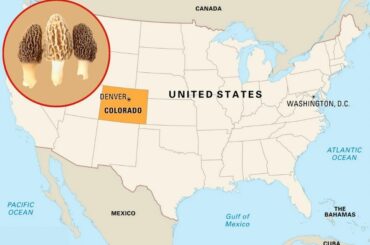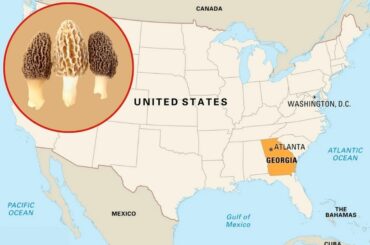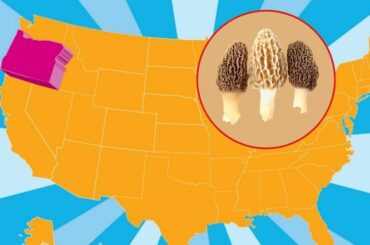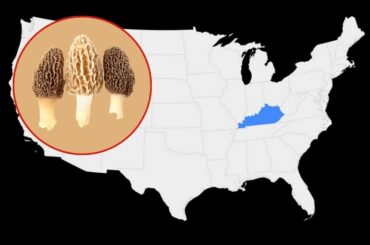Have you seen this bizarre mushroom? It is not like regular mushrooms, they produce spores on the pendant, tooth-like or spine-like projections rather than on gills. These projections hang down from under the caps of their fruiting bodies. And their cap produces red color blood-like substance They can be found growing on the ground in solitary or in groups. But is bleeding tooth fungus edible? Let’s find out that in this article.
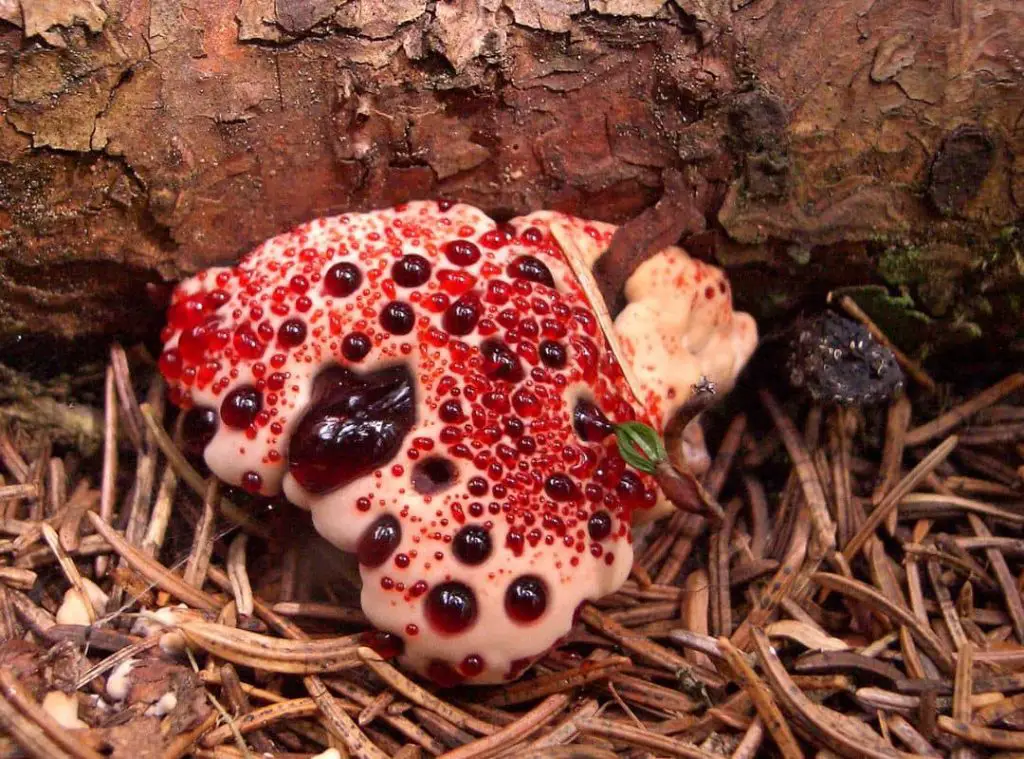
Is bleeding tooth fungus edible?
Contents
- 1 Is bleeding tooth fungus edible?
- 2 What is a bleeding tooth mushroom?
- 3 Characteristics of Bleeding tooth fungus
- 4 Spore print and microscopic characteristics
- 5 Is bleeding tooth fungus toxic?
- 6 What happens if you eat bleeding tooth fungus?
- 7 Is Bleeding tooth fungus rare?
- 8 Why do they call Strawberries and Cream mushrooms?
- 9 What is the red stuff oozing out of the bleeding tooth fungus?
- 10 Where to find bleeding tooth fungus?
Hydnellum peckii, commonly known as bleeding tooth fungi, is not a poisonous species in general. But they are not edible. This is probably associated with their extremely bitter taste. Even the dried Hydnellum peckii retains this bitter taste in them. Although the bleeding tooth fungi are not edible, It is widely known to be useful in medical research.
What is a bleeding tooth mushroom?
Hydnellum peckii is a species of fungus which belongs to the genus Hydnellum of the family Bankeraceae. Hydnellum peckii has several common names, all attributable to its peculiar appearance. Hydnellum peckii is called “Bleeding tooth fungus”, “strawberries and cream”, “bleeding Hydnellum”, “red-juice tooth”, “Peck’s hydnum”, and the “devil’s tooth”.
They form mutually beneficial relationships with coniferous trees such as oaks, pines, and birch trees. This symbiotic relationship is especially beneficial to the host tree as the bleeding tooth fungus produces enzymes that mineralize organic compounds.
Through this, the fungus facilitates the transfer of nutrients to the tree and in turn, receives fixed carbon. The cap shape of the fruiting body is highly variable. Most are funnel-shaped with a white edge. The mushroom is attached to the substrate with a thick stem. Fruiting bodies of Hydnellum peckii when grown together in a bunch, appear to be fused together in a condition called confluence. The odor of the fruiting body is reported to be similar to Hickory nuts and many describe the smell as disagreeable.
Young fruiting bodies secrete a red substance from the top of their caps. These are known to be guttation droplets formed due to the excessive absorption of water from the substrate. These droplets contain a red pigment which is known to have anticoagulant activities. This variety of fungi can be easily identified due to this appearance when young. But as the fruiting body gets old, the cap turns brownish and featureless. The bleeding tooth fungus is popularly used to make dye commercially and is widely experimented with in the pharmaceutical industry.
This mushroom variety is found to be containing antibacterial substances, and an anticoagulant compound that is used to prevent blood clots in the human blood vessels. Some recent research done on the flesh of the fungus claims to have found a compound called thelephoric acid, which may have the potential to treat Alzheimer’s disease in the future. The bleeding tooth fungus is one of the few species in the Bankeraceae family to be studied well, likely due to its therapeutic potential in the pharmaceutical industry.
Characteristics of Bleeding tooth fungus
Cap
The cap surface of the bleeding tooth fungi can be either flattened or convex. The shape of the cap can be highly variable. The surface of the cap often is uneven and has dents. The cap’s upper surface is often covered with minute hairs giving it a velvety texture, but with age, these hairs can be sloughed and give the cap a smooth texture.
The cap size normally ranges from 4cm to 10cm. In some cases, it can even grow up to 20cm. This can be a result of several mushrooms fusing together as they grow up in close proximity. The cap color is whitish in the young blooms and can turn brownish in older mushrooms. The flesh has a pale pinkish color.
Gills/Teeth
Teeth-like structures can be found on the underside of the caps instead of the gills. These teeth-like projections produce spores. The spore print is brown in color. The teeth-like projections are sometimes called spines. They are slender, cylindrical and taper down. The teeth can be 5mm long and grow shorter near the cap’s edge. They are grown closely fitted with each other, with nearly 3-5 teeth each mm2. The teeth are pinkish white in young caps and turn grayish brown with age.
Stem
The mushroom is attached to the substrate with a thick, short stem. The stem can root into the ground up to several centimeters in a bulb. The length of the stem reaches up to 5cm and grows up to 1-3cm in width.
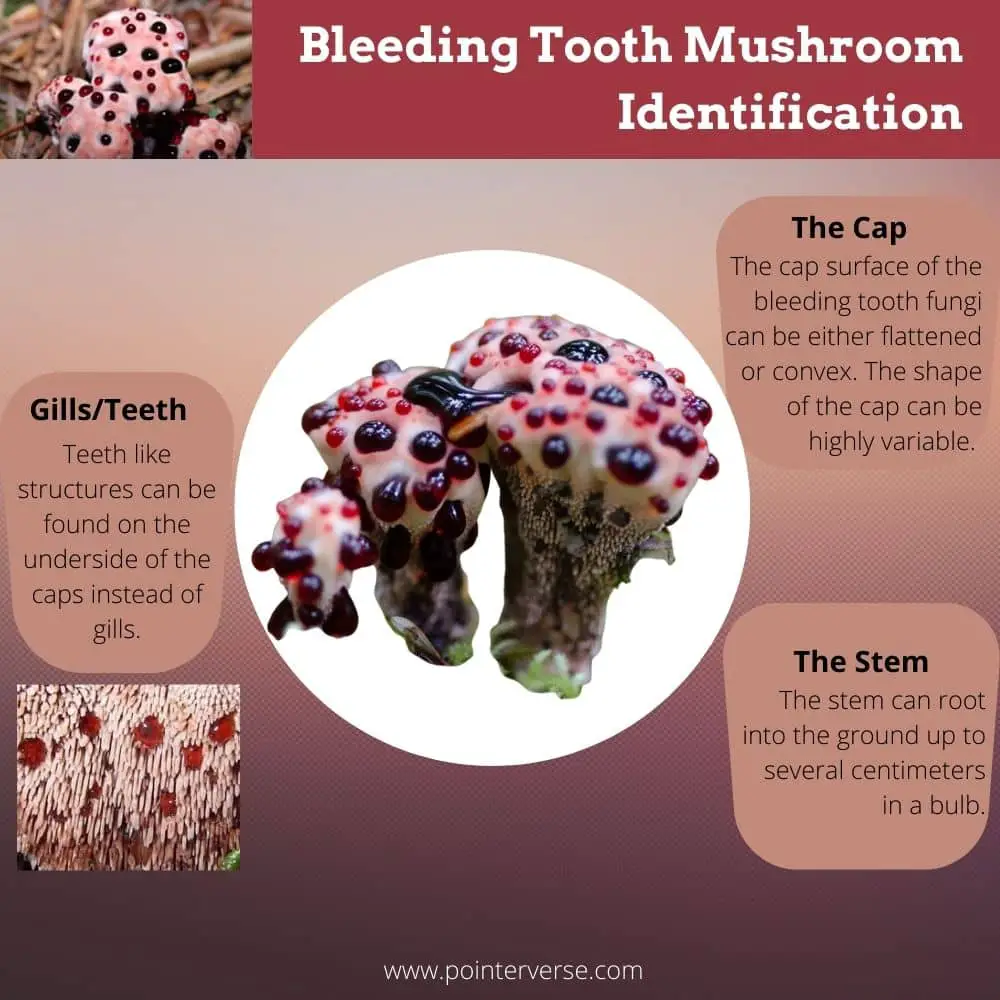
Spore print and microscopic characteristics
The spore print of the bleeding tooth fungus appears brown in the deposit. The microscopic appearance of the spores is spherical and ends up at a small point. The surface of the spores is covered with small, wart-like nodules. The size of the spores is between 5.0–5.3 by 4.0–4.7µm. The hyphae that form the cap are translucent and have a smooth texture with thin cell walls. The cells can be 3–4 µm thick. The hyphae in the cap form a complex network of cells. They are divided by septa and have short branches connecting one cell to the other. The basidia, the spore-bearing cells, are club-shaped and each has four spores.
Is bleeding tooth fungus toxic?
The Bleeding Tooth Fungus is not toxic. But it has an extremely bitter taste. Therefore not recommended to be used in food items.
What happens if you eat bleeding tooth fungus?
Despite its appearance similar to a Danish fruit pastry, this fungus is not recommended for consumption. Though, there is no harm in consuming bleeding tooth fungus if you can tolerate its bitterness. The fungus is not known to be toxic or lethal when consumed. But this variety of fungus is not popularly known as an edible species. The bleeding tooth fungus also can be quite rare to find and can have an unflattering smell. Therefore, not used in culinary practices.
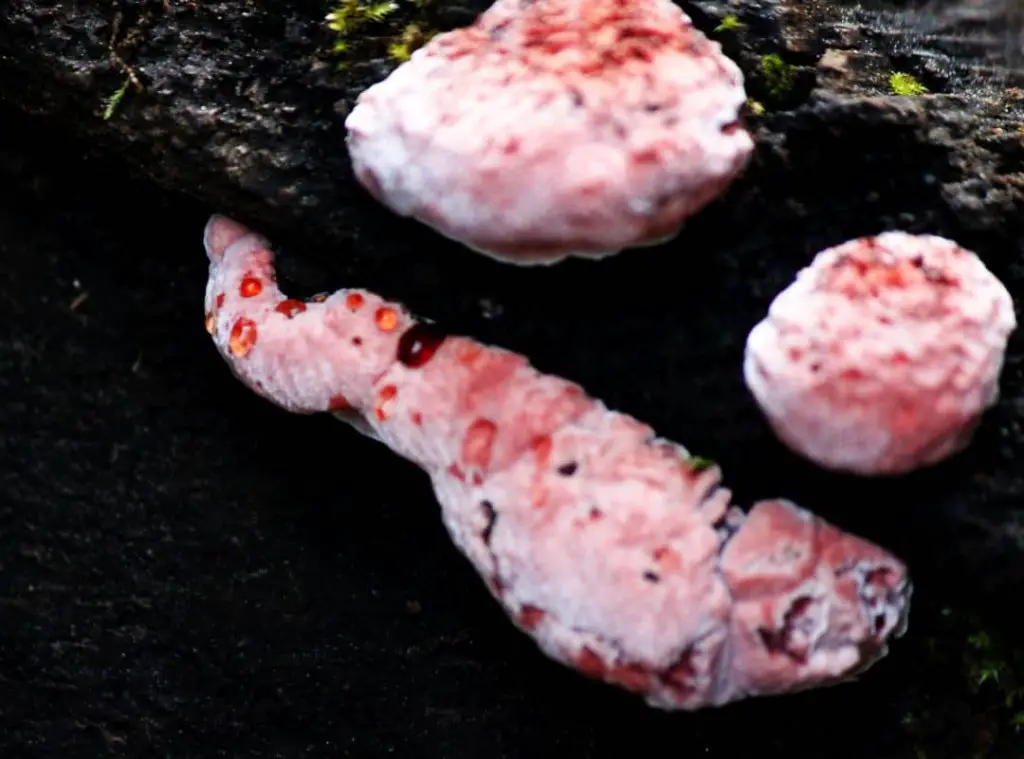
Is Bleeding tooth fungus rare?
The Bleeding tooth fungus is a woodland mushroom. It is a somewhat rare species. Especially in its young oozing form. Most often found in northern mainland Europe and in North America. In some years Bleeding tooth fungus can be found in abundance but the appearance is much localized.
Why do they call Strawberries and Cream mushrooms?
The Hydnellum peckii is known to have several common names including “bleeding Hydnellum”, the “red-juice tooth”, “Peck’s hydnum”, the “bleeding tooth fungus”, and the “devil’s tooth”. It is also popularly called “Strawberries and cream mushroom”. This name is mostly associated with its appearance. The caps of the young fruiting bodies are white in color and secrete a dark red juice from their pores. It instantly looks like a Danish pastry topped with strawberry jam, hence the name.
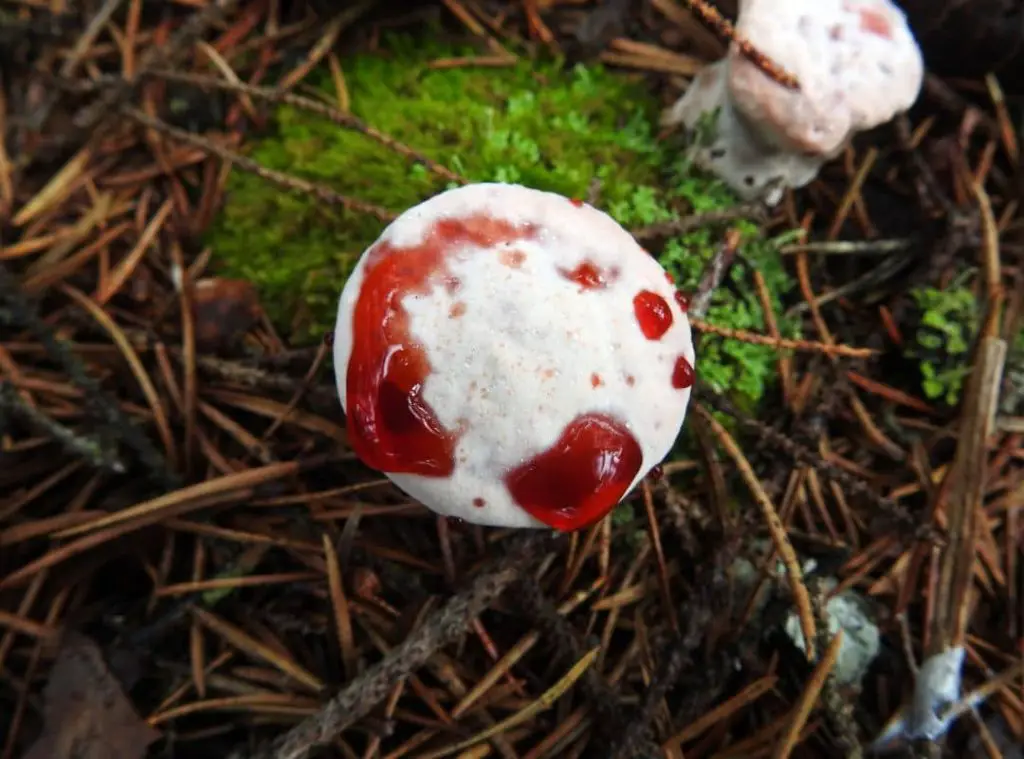
What is the red stuff oozing out of the bleeding tooth fungus?
Young fruiting bodies of bleeding tooth fungus, which grows in moist places, can secrete bright red droplets from their pores. The bright red color is due to a pigment in the mushroom. This secretion is known to contain compounds with anticoagulant activities as well as anti-bacterial activities. One of the compounds isolated from the bleeding tooth fungus is atromentin. This compound is found to have a similar capacity for the anti-coagulation of blood.
The “Bleeding” from the mushroom cap happens when the substrate on which they grow, gets soaked with water. The roots of the mushroom absorb this water. When the roots absorb excess water, the pressure inside the mushroom gets higher and the excess needs to be discarded.
So the bleeding tooth fungus does this via the pores in the caps. When the excess water travels to the surface of the cap through the flesh of the mushroom, it gets mixed with the red pigment in the flesh and comes out as red fluid which resembles blood and forms into small bubbles on top of the cap. The red pigment in bleeding tooth mushrooms is also used in the production of dyes. The colors produced can range from beige to various shades of blue or green depending on whether or not you use a dye fixative substance, commonly known as mordant.
Where to find bleeding tooth fungus?
The bleeding tooth fungus mainly grows in woodland habitats. They are known to prefer mountainous or subalpine ecosystems. They are known to develop mutually beneficial symbiotic relationships with coniferous trees such as; oaks, pines, and birch trees. The substrate of the bleeding tooth fungus is soil among mosses and pine needles. This variety of fungi prefers loose and sandy soil.
They can be found solitary or in clusters or scattered. The mushrooms bloom from August to October each year. The fungus is widely distributed in North America and is especially common in the Pacific Northwest. It is also found in Alaska and North Carolina. In the Puget Sound region of the US state of Washington, it is found in association with Douglas fir, fir and hemlock. Along the Oregon coast, it has occurred under lodgepole pine.
In addition to North America, the fungus is commonly found in Europe, and it is known to be found in Italy, Germany, and Scotland. The species is more common in Europe than in America but is rare to be found in countries like Norway, the Netherlands, and the Czech Republic. The recent rareness of bleeding tooth fungus might be a result of increasing pollution in central Europe. Bleeding tooth fungus has recently been found even in Iran and Korea. This is the first time they have been reported outside of Europe and North America.
Read Next : Peziza Varia | An Unusual Mushroom |

